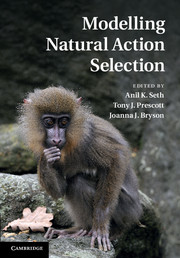Book contents
- Frontmatter
- Contents
- Foreword
- Preface
- Contributors
- 1 General introduction
- Part I Rational and optimal decision making
- Part II Computational neuroscience models
- 9 Introduction to Part II: computational neuroscience models
- 10 Action selection and refinement in subcortical loops through basal ganglia and cerebellum
- 11 Cortical mechanisms of action selection: the affordance competition hypothesis
- 12 Toward an executive without a homunculus: computational models of the prefrontal cortex/basal ganglia system
- 13 Hierarchically organised behaviour and its neural foundations: a reinforcement-learning perspective
- 14 The medial reticular formation: a brainstem substrate for simple action selection?
- 15 Understanding decision-making deficits in neurological conditions: insights from models of natural action selection
- 16 Biologically constrained action selection improves cognitive control in a model of the Stroop task
- 17 Mechanisms of choice in the primate brain: a quick look at positive feedback
- Part III Action selection in social contexts
- Index
- Plate section
- References
14 - The medial reticular formation: a brainstem substrate for simple action selection?
from Part II - Computational neuroscience models
Published online by Cambridge University Press: 05 November 2011
- Frontmatter
- Contents
- Foreword
- Preface
- Contributors
- 1 General introduction
- Part I Rational and optimal decision making
- Part II Computational neuroscience models
- 9 Introduction to Part II: computational neuroscience models
- 10 Action selection and refinement in subcortical loops through basal ganglia and cerebellum
- 11 Cortical mechanisms of action selection: the affordance competition hypothesis
- 12 Toward an executive without a homunculus: computational models of the prefrontal cortex/basal ganglia system
- 13 Hierarchically organised behaviour and its neural foundations: a reinforcement-learning perspective
- 14 The medial reticular formation: a brainstem substrate for simple action selection?
- 15 Understanding decision-making deficits in neurological conditions: insights from models of natural action selection
- 16 Biologically constrained action selection improves cognitive control in a model of the Stroop task
- 17 Mechanisms of choice in the primate brain: a quick look at positive feedback
- Part III Action selection in social contexts
- Index
- Plate section
- References
Summary
Summary
The search for the neural substrate of vertebrate action selection has focused on structures in the fore- and mid-brain, particularly on the basal ganglia. Yet, the behavioural repertoire of decerebrate and neonatal animals suggests the existence of a relatively self-contained neural substrate for action selection in the brainstem. We propose that the medial reticular formation (mRF) is this substrate's main component, reviewing evidence that the mRF's inputs, outputs, and intrinsic organisation are consistent with the requirements of an action selection system. We argue that the internal architecture of the mRF is composed of interconnected neuron clusters; our quantitative model of this anatomy suggests the mRF's intrinsic circuitry constitutes a small-world network, and may have evolved to reduce axonal wiring. We use computational models to enumerate and illustrate potential configurations of action representation within the internal circuitry of the mRF. We show that each cluster's output could represent activation of an action component; thus, co-activation of a set of these clusters would lead to the coordinated behavioural response observed in the animal. New results are presented that provide evidence for an alternative scheme: inputs to the mRF are organised to contact clusters, but recruit a pattern of reticulo-spinal neurons from across clusters to generate an action. We propose that this reconciles the anatomical structure with behavioural data showing action sequencing is degraded, rather than individual actions lost, as the mRF is progressively lesioned. Finally, we consider the potential integration of the basal ganglia and mRF substrates for selection and suggest they may collectively form a layered/hierarchical control system.
Introduction
All animals must continuously sequence and coordinate behaviours appropriate to both their context and current internal state if they are to survive. It is natural to wonder what parts of the nervous system – the neural substrate – evolved to carry out this action selection process. For simpler animals, like the nematode worm Caenorhabditis elegans and the leech, a circumscribed behavioural repertoire is handled by specialist neurons that direct motor responses to specific stimuli (de Bono and Maricq, 2005; Kristan et al., 2005; Stephens et al., 2008). The sensory apparatus and motor behaviours are largely a product of these animals’ ecological niche, and hence so too is the neural network that handles the action selection process.
- Type
- Chapter
- Information
- Modelling Natural Action Selection , pp. 300 - 329Publisher: Cambridge University PressPrint publication year: 2011



